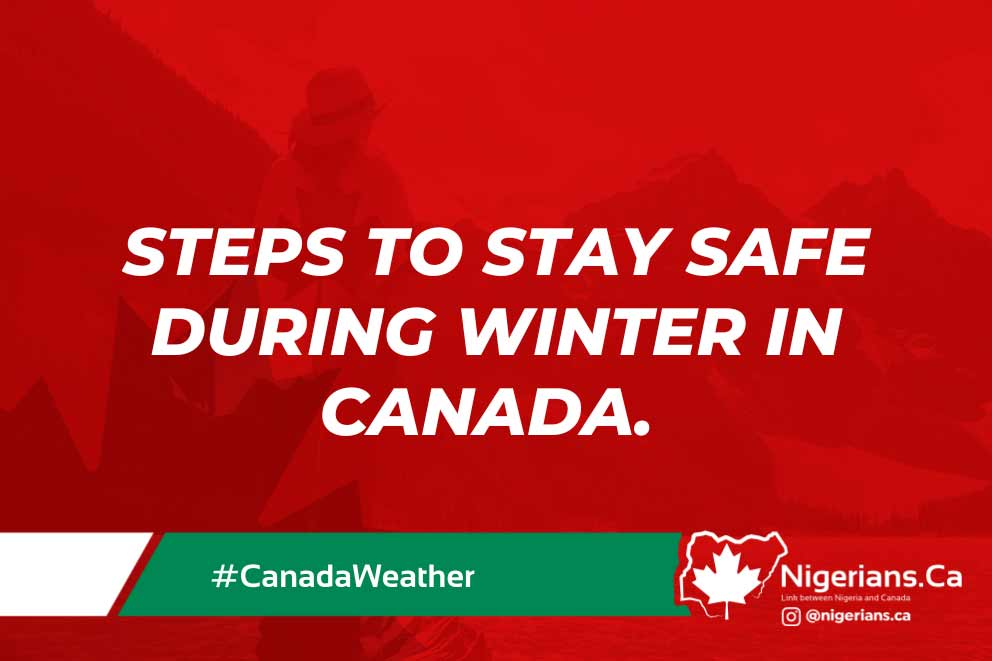The winter season is upon us! For newcomers to Canada, the winter season may be strange and difficult.
Not to worry, here are a few tips to help you survive the cold and dark months.
Stay Updated With The Weather Forecast.
- Check the Environment Canada- Weather forecast before going out.
- Listen to the wind chill warning. Warnings are based on local climate and are issued when significant wind chills are expected.
- Visit Environment Canada's new Weather and Meteorology website.
Weather forecasts are available through radio and TV broadcasts, Environment Canada's Weatheradio service, and online.
Plan Ahead
Develop a cold weather safety plan to address safety concerns when it's very cold or when the wind chill is significant. For example, schools could hold recess indoors, outside workers could schedule warm-up breaks, and those involved in winter recreation could reduce the time they spend outdoors.
Dress Warmly
- Dress in layers, with a wind-resistant outer layer.
- When it is cold, wear a hat, mittens or insulated gloves. Keep your face warm with a scarf, neck tube or face mask.
- Wear warm and waterproof footwear. Cover as much exposed skin as possible when it is very cold or when the wind chill is significant. Cover as much exposed skin as possible when it is very cold or when the wind chill is significant. Your body's extremities, such as the ears, nose, fingers, and toes, lose heat the fastest.
Stay Safe Indoor
Winter is a busy season for ‘fires’ in Canada. That's why it's important to be mindful of fire prevention and safety. Make sure you have working smoke alarms, don't leave burning candles unattended and if a pot catches fire while cooking, put a lid on it.
Stay Active
Walking or running will help keep your body warm by generating body heat. It's important to maintain an active lifestyle, even during the colder months. Participate in winter sports like skiing, snowboarding, or ice-skating, or simply go for a walk to stay active and enjoy the outdoors. Regular exercise can also help combat seasonal affective disorder, which some people experience during the winter months due to reduced sunlight.
Be Mindful of Driving Conditions
While you can’t control the weather, you can decide to stay home and avoid driving, but if you must go out, make sure your car is in good condition and the roads are in good condition as well. Go slow and be careful especially on bridges and overpasses. Keep an ice scraper in your car to clean all windows before getting behind the wheel.
Learn to Drive in Winter Conditions
Snow, ice, and reduced visibility can make driving in Canada challenging during the winter. Familiarize yourself with winter driving techniques and consider taking a winter driving course to build confidence and skills.
Stay Hydrated And Moisturize
Cold weather and indoor heating can cause dry skin and dehydration. Drink plenty of water and use moisturizers to keep your skin healthy.
Familiarize Yourself With Local Customs
Canadians have their own set of customs and practices when it comes to dealing with the cold, like removing shoes when entering homes to avoid tracking in snow and dirt. Observing and adopting these customs can help you fit in and feel more comfortable.
Take Advantage Of Indoor Activities
When the weather is too harsh to spend time outside, explore indoor activities like museums, art galleries, or shopping centers to stay entertained and avoid cabin fever.
Be Patient And Give Yourself Time To Adjust.
Adapting to a new climate takes time, and it's normal to feel a bit out of your comfort zone at first. Be patient with yourself and remember that that adapting to a new climate can feel strange at first. It's okay if you don't feel comfortable right away. Give yourself time to get used to the weather and surroundings. Your body and mind need time to adjust. Don't rush it, and soon you'll feel more at home in the new climate.





